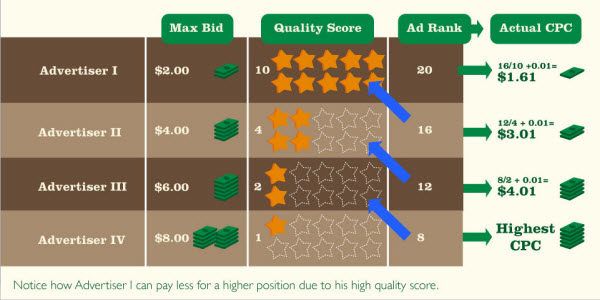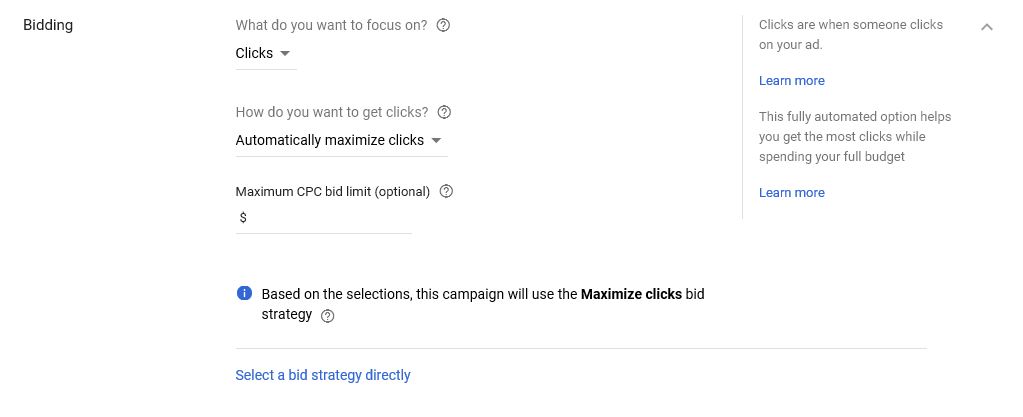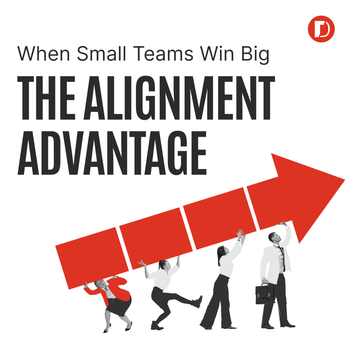Bid Management for Google Ads: What You Need to Know
by Aden Andrus • September 13, 2019
Bid management can be one of the trickiest aspects of running a paid search campaign. It’s an intricate balance between the amount you’re willing to pay for a click and how badly you want that click.
To be honest, no one’s perfect at it.
However, as challenging as bid management can be, it can make or break your campaigns, so if you can crack the code, you’ll reap the benefits for years. And, the good news is, you don’t have to figure it all out on your own.
At Disruptive Advertising, we’ve been learning the ins and outs of bid management for years. We’ve audited thousands of Google Ads campaigns and we have a pretty good feel for what works…and what doesn’t.
In this article, we’re going to share the basics of what we’ve learned. We’re going to explain how the keyword auction works, how that plays into your bidding decisions and then discuss your bid management options. Sound like a plan? Let’s get started!
The Keyword Auction
The secret to Google Ads success is understanding the keyword auction. Google Ads is a pay-per-click (PPC) advertising platform. That means you have to pay for every click you get on your paid search ads.
Back in the early days of paid search, that wasn’t that big of a deal. There wasn’t a ton of competition, so clicks were pretty cheap.
Those days are over.
Today, Google Ads is incredibly competitive. Almost any keyword you want to rank for is filled with businesses fighting to be seen. If you want your ads to show up, you’re going to have to outbid them in the keyword auction.
How the Keyword Auction Works
No, advertising on Google doesn’t mean you’ll spend the rest of your PPC advertising career sitting in an auction house listening to John Giannandrea (Google’s head of search) rattle off keywords at high speed.
While I’d pay good money to attend that keyword auction, the real keyword auction takes place online. For every keyword you target, you tell Google how much you’re willing to spend to get a click when someone types in that keyword.
That maximum amount is your “bid” for that keyword.
The next time someone conducts a relevant search using your keyword, your bid is entered into the keyword auction. Google Ads looks at all of the bids for that keyword, the quality of the ads and landing pages associated with that bid and then decides where your ad will show up.
Now, since this is an online auction where you don’t know how much your competitors are bidding, you don’t actually have to pay your maximum bid. All Google charges you is the minimum amount necessary to outbid the next lowest advertiser…sort of.
How Quality Score Affects Your Bids
Remember how I mentioned that Google takes your ad and landing pages into account during the auction process? Well, to ensure that they’re delivering valuable content to their users, Google assigns a “quality score” to your ads.
Why do they add this twist to the auction? It’s fairly simple, really.
Google’s whole business model is based on trust. Google’s users believe that if they use Google, they’ll be able to find the content they’re looking for. If Google slips up and starts delivering shoddy results, people will lose trust in Google and find another, better search engine to use.
Google’s organic search results are produced by massive, constantly-refined algorithms that are designed to deliver just the right results at just the right time. With paid search, however, Google is taking a gamble. If an advertiser with an irrelevant ad and wins the keyword auction, it makes Google look bad.
To help prevent this problem, Google gives each of your ads a quality score. If your ads and landing page match the intent of the keywords you’re targeting, your ads will have a high quality score. If they don’t, you get a low quality score.
During the keyword auction, Google uses your quality score to adjust your effective bid. To incentivize advertisers to create high-quality, relevant content that makes Google look good, advertisers with low quality scores are penalized in the keyword auction and must bid higher to rank well. Advertisers with high quality scores are rewarded and can get a higher ranking at a lower price.
In this great infographic from Wordstream, you can get a sense for how this works:
Now, Google’s never fully disclosed how quality score affects your bids, but one thing’s for certain: as in the example above, if you have a great quality score, you can underbid and outrank the competition!
The Quick and Dirty
So, in a nutshell, here’s how the keyword auction works. You pick a keyword and tell Google how much you’re willing to pay for a click. Google looks at your keyword, ads and landing page and assigns you a quality score that adjusts your effective bid.
When your ad is eligible to show up for someone’s search, it’s entered into the keyword auction. Your effective, quality score-adjusted bid is compared to everyone else’s quality score-adjusted bids. Ad position #1 goes to the highest effective bid, position #2 goes to the next highest bid, and so forth.
What do you pay if someone clicks on your ad? Well, that all depends on what your maximum bid was and what it took to outbid the next-highest bidding advertiser. But, if you’re managing your bids properly—which is what we’re going to get into in the next section—it should hopefully be a price point that fits your needs.
Bid Management on Google Ads
So, now that we’ve talked about the keyword auction process, the question is, How do you make that process work for you?
This is where you need to get strategic.
In any online marketing campaign, you have a budget that you’re willing to spend and results that you’re hoping to get. On many advertising platforms—like Facebook or YouTube—your goal is to build brand awareness. You want more people to know about your business.
On Google Ads, however, your goals are a bit different. Unlike Facebook or YouTube, people who are searching on Google are actively looking for something. They already know that they have a problem and they want to find a solution.
As a result, when most businesses advertise on Google Ads, they aren’t trying to build awareness for a problem or their business in general. Instead, they’re trying to capture that purchase intent. They want people to see their ads, click and convert.
With that in mind, your paid search bidding strategy should revolve around getting results. Sales, online chats, phone calls, form submissions—whatever your business needs to succeed.
With Google Ads, you’re looking for a good return on investment (ROI).
To help you out with that, when you first create a campaign on Google Ads, Google asks you a few questions you can use to figure out what strategy you want to use:
This is a good place to start, but you know your business a lot better than Google does (or will even after you answer their questions), so if you really want to get serious about managing your bids, click “Select a bid strategy directly” to bring up the following options:
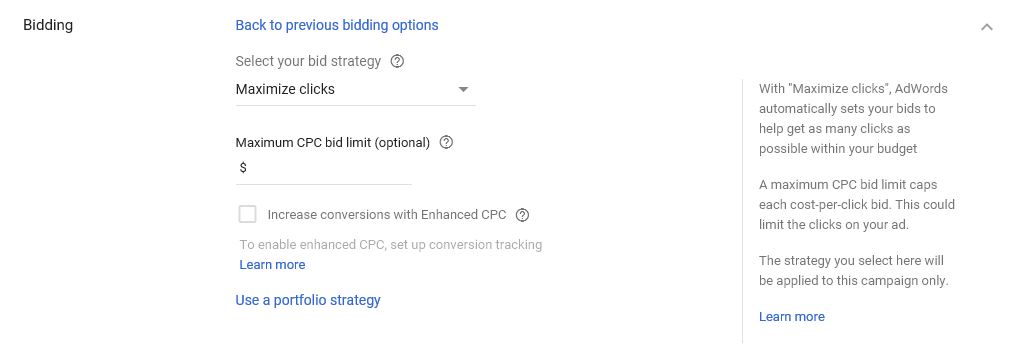 Here, you can see all of the different bid management options available to you. Depending on your skill level, the age of your Google Ads account and what you’re trying to achieve, each of these options is potentially viable, so let’s walk through all of them.
Here, you can see all of the different bid management options available to you. Depending on your skill level, the age of your Google Ads account and what you’re trying to achieve, each of these options is potentially viable, so let’s walk through all of them.
Manual CPC
To be honest, most advertisers prefer “manual CPC” because it’s the only option that gives you “full control” over your bids. “Full control” is in quotes here because a lot of what you pay is still up to Google. Even if you have the perfect bid management strategy, if Google doesn’t like your ads or landing pages, your quality score will suffer…and so will your campaigns.
But, as far as bid management goes, manual CPC is the best way to indulge your inner control freak.
That being said, manual cost-per-click (CPC) does come with its disadvantages. As your campaigns grow, it can be hard to stay on top of and optimize all of your bids. If you don’t have a ton of time to manage your campaigns, you may soon find that your campaigns aren’t delivering the results you need.
We actually see this problem quite a bit in the campaigns that we audit. Advertisers choose manual CPC because they don’t want to give Google control of their campaigns, but then they don’t spend enough time in their own campaigns to actually figure things out…and wonder why Google Ads doesn’t work for them.
So, if you’re the anal-retentive type and you know that you’re going to stay on top of your campaigns, manual CPC is a great way to go. If not, though, Google’s automated options are actually getting pretty good, so it may be worth your while to explore them.
Automated Bid Management
In contrast to manual bid management, automated bid management puts Google in charge of your bid strategy. You pick a goal that you want Google to optimize for—like clicks, conversions, etc—and Google’s algorithms choose your bids for you.
How much Google bids on your behalf will change every time your keywords go up for auction. That can be a bit scary, especially since Google’s algorithms track changes over time, not immediately. So, if there are any drastic changes in the marketplace, you’ll have to take over.
That being said, in many cases, we’ve seen much better results with automated bidding than manual bidding. You’ll just want to make sure that you keep an eye on your campaigns if you’re running any of the bidding strategies below.
Target CPA
The Target CPA bidding strategy focuses on driving as many conversions as possible at your target cost-per-acquisition (CPA). Though some bids will cost more or less than your target cost, they’ll average out to ensure that you’re staying where you need to overall.
This is one strategy that gives you some good control over your bidding, allowing you to set a specific target CPA.
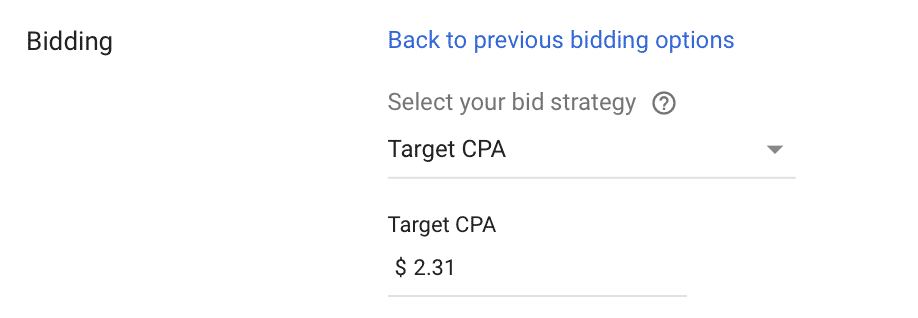
This bidding strategy can work well when you have an average CPA you want to stay near (but not necessarily under for every click you get). Before choosing this, have a good idea of what you can spend in order to maintain profitability when getting a sale, factoring in everything that can lead to a rise in costs or loss of ROI.
Target ROAS
With the Target ROAS strategy, Google sets bids to maximize your potential return on ad spend (ROAS). This bidding strategy can only be applied to a single campaign instead of multiple campaigns.
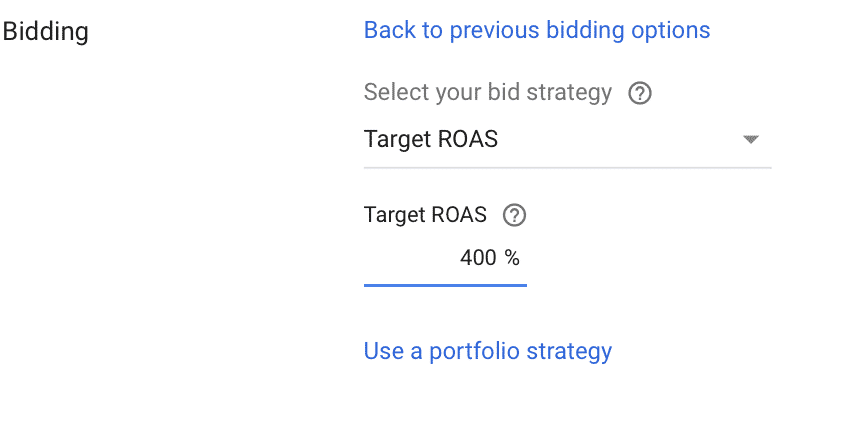
Your ROAS is the conversion value you’d like to get out of every dollar of ad spend you invest, telling you the return on ad spend you’re getting. If you want to make $4 in sales for every dollar spent on your ads, the ROAS would be 400%.
Maximize Clicks
This bidding strategy is self-explanatory: it will work to get as many clicks on your ad as possible, going through your daily budget to make this happen. You can also set a bid limit, which is nice as it ensures that you won’t end up blowing your budget on a few clicks.
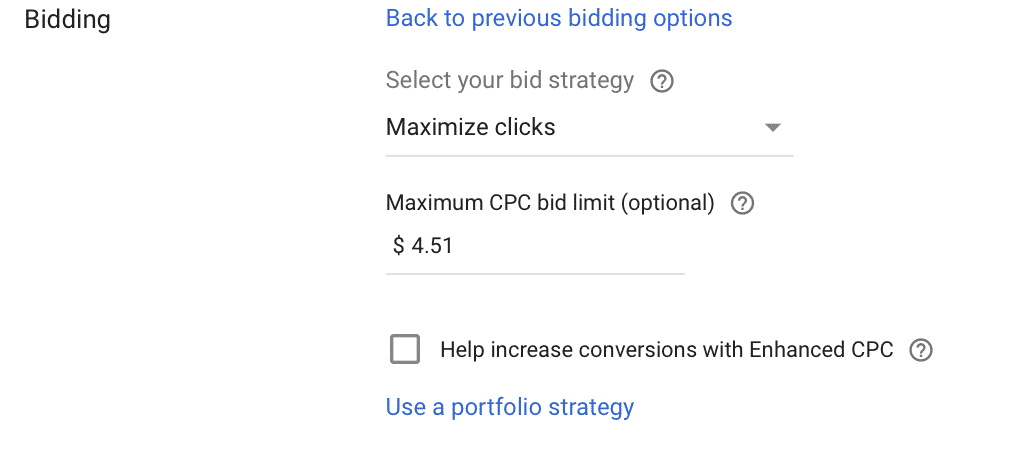
Here’s what you need to keep in mind with the maximize clicks bidding strategy:
- It’s almost always a good choice to set that bid limit so that Google doesn’t go through your budget in a way you won’t be happy with. Clicks are good, but not if they cost too much.
- This can be a good bidding option if you want to drive traffic to your site or a specific landing page.
- We recommend this most for audiences who currently have a strong conversion history on your campaigns and you want to step traffic up further.
- Google Ads will sometimes aggressively spend here to chew up your budget. They want to get you those clicks, but again, this can come at a cost, so keep the bid limits reasonable.
Maximize Conversions
Maximize conversions is similar to the above bidding strategy, but the focus here is on getting conversions instead of just clicks. Google will go through your budget quickly to get you those conversions whenever possible.

You’ll notice, however, that—unlike maximize clicks—this strategy doesn’t let you set a bid cap. This can make things rather challenging, since there’s a huge risk that Google can burn through your ad spend with too-high CPCs that get you some results, but not at a price that’s profitable.
Target Search Page Location
This bidding strategy prioritizes ad placement, letting advertisers bid on either the top of the search page or on the first page of results. You get to pick which location you want to prioritize.
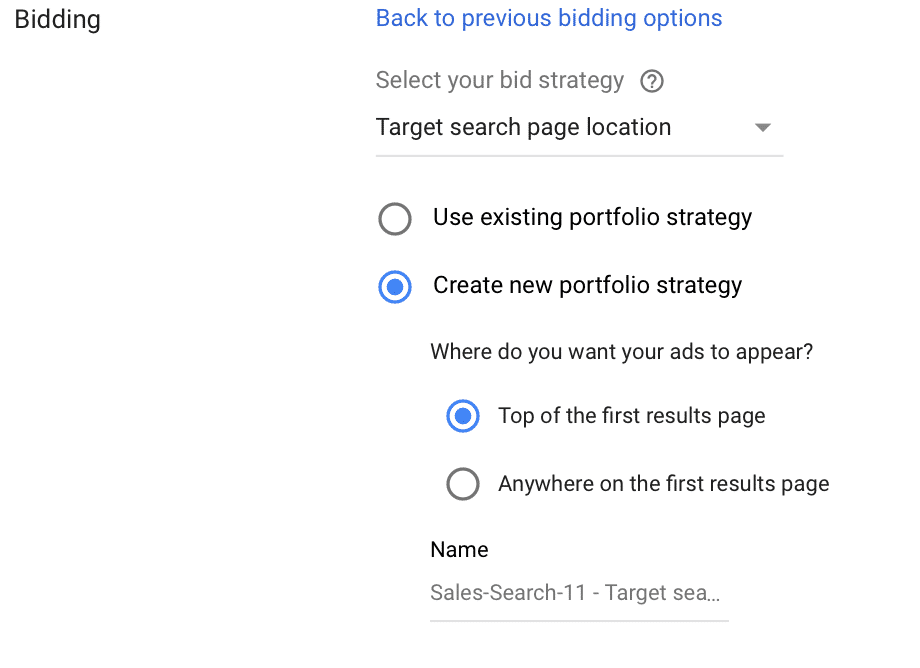
The idea behind this bidding strategy is that Google will automatically up your bid when necessary to get the high-visibility results you need. However, make sure that the position you’re after is worth it before choosing this option, and if so, keep a close eye on your CPCs.
Target Outranking Share
Like the target search page location bidding strategy, target outranking share focuses on the placement of the ad instead of the value or cost of a certain action. This strategy, however, prioritizes not just good placements but actually outranking very specific competitors.
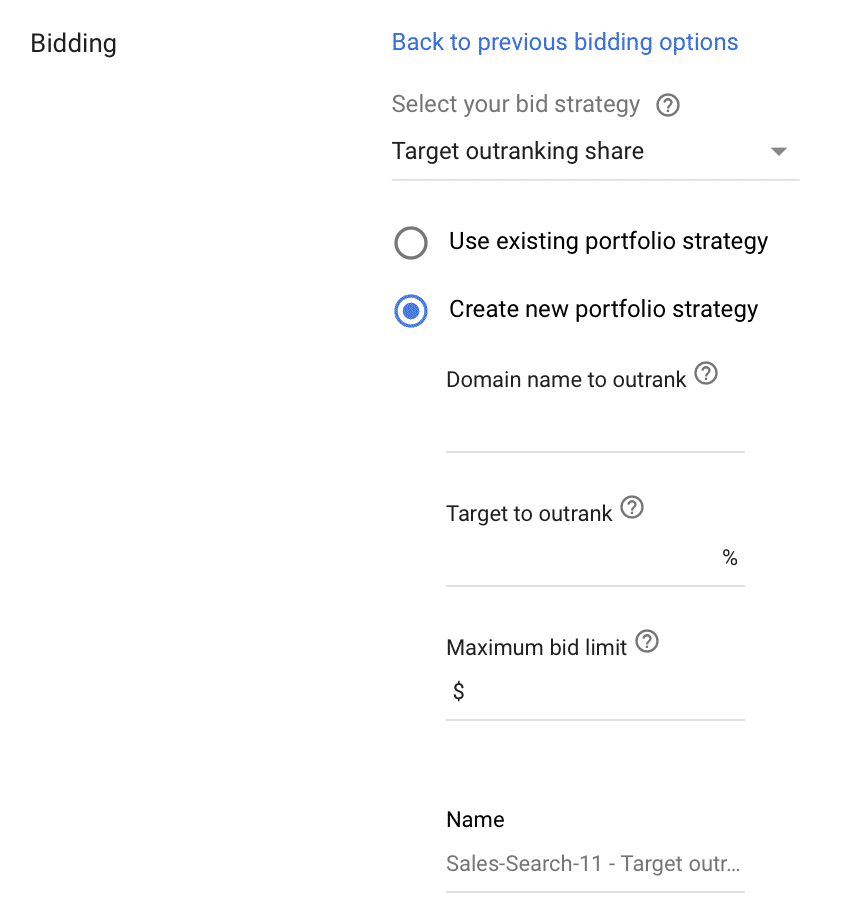
Let’s say you are a small shoe company and you’re sick of Nike dominating the traffic. You can enter in their domain name as the one you want to outrank, and hopefully take control of that first-place ad result for “running shoes” and “cross trainers.”
Using target outranking share, you can try to outrank specific competitors who are continually stealing some of those high-value keywords. If you can afford to watch your CPCs increase so that you can snag some of those sales, full steam ahead.
Keep in mind that with this strategy, there’s the option to set a bid limit. Do this. Big names have big budgets, and you don’t want to go broke trying to keep up.
Enhanced CPC
Enhanced CPC can be applied on its own, but it can also be applied to other bidding strategies, too. It stands for “enhanced cost-per-click,” and while it’s similar to manual bidding, it allows Google to adjust your bid—even if you’ve set it manually. Google will adjust the bid depending on the likelihood for a sale, increasing it if the likelihood is higher and decreasing it if lower.

Enhanced CPC has been around for a while and it has a history of helping to boost click-through rates (CTR) and conversion rates, but it often comes at the cost of a higher CPC. This limits the ability to set proper bid caps, allowing Google to make the final decision. This can result in major loss in profitability, which isn’t a risk most businesses want to take.
Target Impression Share
This is a relatively new bidding strategy that prioritizes bidding to reach a target percentage of the impression share.
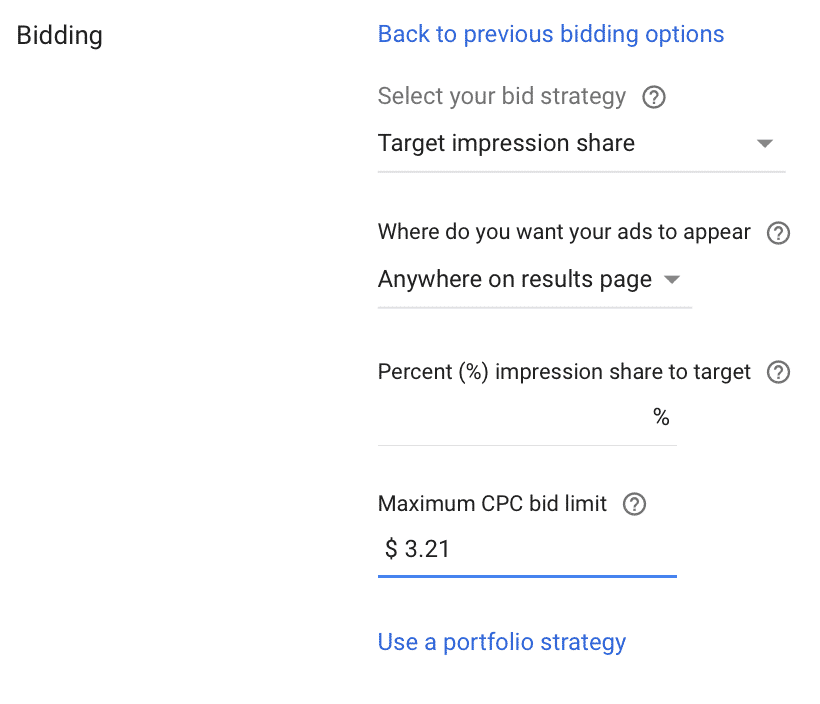
This is great…if you know what your profitable keywords are and want to make the most of your budget.
Essentially, impression share tells you what percentage of searches you’re appearing in that you were capable of showing up in based on targeting and keywords.
Sometimes, a low impression share is at least partially the result of low bids and this strategy can help you combat that. The higher the impression share, the more people are seeing your ad and the more chances you have at a click or conversion.
Here are a few things to keep in mind if you try this bidding strategy:
- The ability to set a maximum CPC is, once again, valuable. Use it, because you don’t need to chew up your entire budget to simply get more impressions that may not even convert.
- You can prioritize for different page locations, including Top of the Page and Anywhere on the Page, allowing you to decide if you only want to bid on impressions at the very top of visibility.
Impression share simply means having your ad show up more often. That’s all it’s optimizing for, not specific actions. If you know that more impression share will lead to more sales or conversions, this bidding strategy can do wonders. If not, it can be a huge waste of money.
Setting Your Bids
Bid management is actually a fairly complex process. When determining how much you should bid, you’ll want to consider:
- The average CPC of your chosen keyword(s). Different keywords will cost more than others due to volume and competition levels. If you really want to have placements for high competition keywords, you’ll need to bid more. Keyword research tools like SEMrush can show you the estimated CPC of individual keywords.
- Your budget. If you have a smaller budget and want to make it go further, consider bidding on lower-cost keywords or making smaller bids.
- Your ROI. Google Ads is typically used for customer acquisition, so while a few dollars for a single click or conversion can seem expensive, they are often worth the investment. If it costs $5 to get a conversion, but it immediately brings in $15 in pure revenue, that’s not a bad deal, especially if your customer lifetime value (LTV) may be closer to $450.
You need to keep all of these factors in mind when deciding how much you want to bid on Google Ads. But, you can’t just pick one bid and use it for all of your campaigns.
Remember, different campaigns and keywords target different buyer personas, which are worth different amounts to your business. Your bids should reflect who you’re targeting and what the goal of your campaign is.
Adjusting Your Bids
Of course, even after you’ve set your initial bids, Google Ads isn’t exactly a “set it and forget it” advertising platform. After all, when you pay for every click, a simple mistake can cost you an awful lot over time.
As you’re monitoring your campaigns, you may notice different scenarios that could indicate that it’s time to adjust your bid. You can adjust your bids at any time, but here are a few scenarios where you might want to adjust your bids:
- If your CPC is coming in way under budget, but you want to improve your position in the ad display, increase it.
- If your cost-per-conversion is too high, but you’re in a top position in the ad rankings and you want to stick with the keyword, drop your bid slightly. This can bring the cost-per-conversion down while still getting you placements.
- If you’re getting a ton of conversions, but your profit margin is low, change up your bid.
- If you’re paying for a lot of clicks but not getting conversions, switch up your bid strategy or change your keywords.
Good bid management is an ongoing process. The market is constantly changing and if you aren’t changing your bids in response, you can quickly find that either your ads aren’t showing or you’re paying too much for your clicks.
Conclusion
Good bid management on Google Ads can be the difference between profitable campaigns and flushing money down the toilet. Paid search is always tricky, but if you can figure out your bid management strategy, you should be well on your way to success.
By the way, if you’d like some help with bid management (or any other aspect of your paid search campaigns), let us know here or in the comments. As mentioned earlier in this article, we have a ton of experience with Google Ads and we’d love to help you get your campaigns on track.
How do you approach bid management? Have any handy strategies to share? Leave your thoughts in the comments below!


